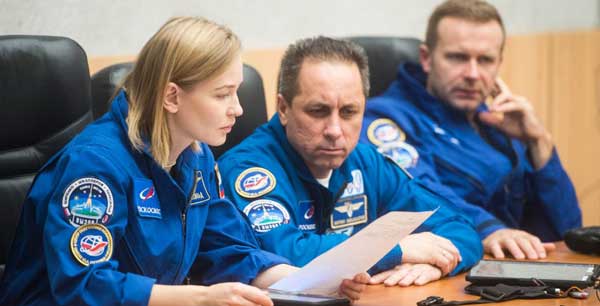
RT interviewed veteran cosmonaut Aleksey Ovchinin about the risks involved in the commercial mission launched to the International Space Station (ISS) last week. On Oct. 5, the Soyuz MS-19 spacecraft flew to the station with professional cosmonaut Anton Shkaplerov and two amateur cosmonauts, actress Yulia Peresild and director Klim Shipenko, who are filming a movie titled “Challenge” there.
Ovchinin, who with NASA astronaut Nick Hague survived an aborted Soyuz launch to the station in October 2018, called the mission “an important milestone for filmmaking.” He also said he supported flights with amateur astronauts aboard.
However, he cautioned the flight entailed additional risks because Shkaplerov was the only fully trained cosmonaut aboard.
“He had to take double responsibility and bear double burden,” Ovchinin said, adding that usually such missions have an onboard engineer, who does a “lion’s share” of work during the flight to the ISS. “Now, he had to do twice as much work that was twice as difficult,” the cosmonaut said.
Yet, even with Shkaplerov onboard, the mission was still somewhat risky, Ovchinin believes. He explained that there could be some emergencies that can only be dealt with by two professionals. “Had such an emergency happened onboard, the spacecraft commander would have had a hard time dealing with it,” he said.
In fact, the Tuesday mission did face an emergency onboard when the Soyuz spacecraft was about to dock with the ISS. Fortunately, it was not one of a kind described by Ovchinin. An automated docking system failed so Shkaplerov had to dock the spacecraft manually and did so successfully.
In the 2000’s, seven paying passengers flew eight times to ISS. (Charles Simonyi flew twice.) On all the flights, the other two Soyuz seats were occupied by professional cosmonauts and astronauts.
Ovchinin also talked about the burdens placed on occupants of the station by amateur astronauts, who he believes are not sufficiently trained.
Yet, every time a space tourist gets onboard, cosmonauts have to “babysit” them due to what Ovchinin calls insufficient training of non-professionals. “Their training is too short. They only get the basics,” he said, adding that “non-professionals have no idea about 90 percent of issues they might face when they launch into space after three months of training.”
Peresild and Shipenko will spend 12 days in space before returning to Earth with cosmonaut Oleg Novitsky aboard the Soyuz MS-18 spacecraft on Oct. 17. Novitsky has been aboard the station since April.
NASA astronaut Mark Vande Hei and Pyotr Dubrov were originally scheduled to return to Earth with Novitsky. However, the inclusion of Peresild and Shipenko means their planned six-month stay in space will be nearly doubled. Vande Hei will set a new American record of 353 days in space when he returns to Earth next March aboard Soyuz MS-19.